MXA RACE TEST: THE REAL TEST OF THE 2025 HONDA CRF450
 THE GEAR: Jersey: FXR Revo, Pants: FXR Revo, Helmet: 6D ATR-2, Goggles: Scott Prospect, Boots: Alpinestars Tech 10 Supervented.
THE GEAR: Jersey: FXR Revo, Pants: FXR Revo, Helmet: 6D ATR-2, Goggles: Scott Prospect, Boots: Alpinestars Tech 10 Supervented.
Q: FIRST AND FOREMOST, IS THE 2025 CRF450 BETTER THAN THE 2024 CRF450?
A: Yes, we can say without a doubt that the 2025 Honda CRF450 fulfills the hopes we had 17 years ago when the last great CRF450, the 2008 Honda CRF450, was replaced by 16 years of average machines.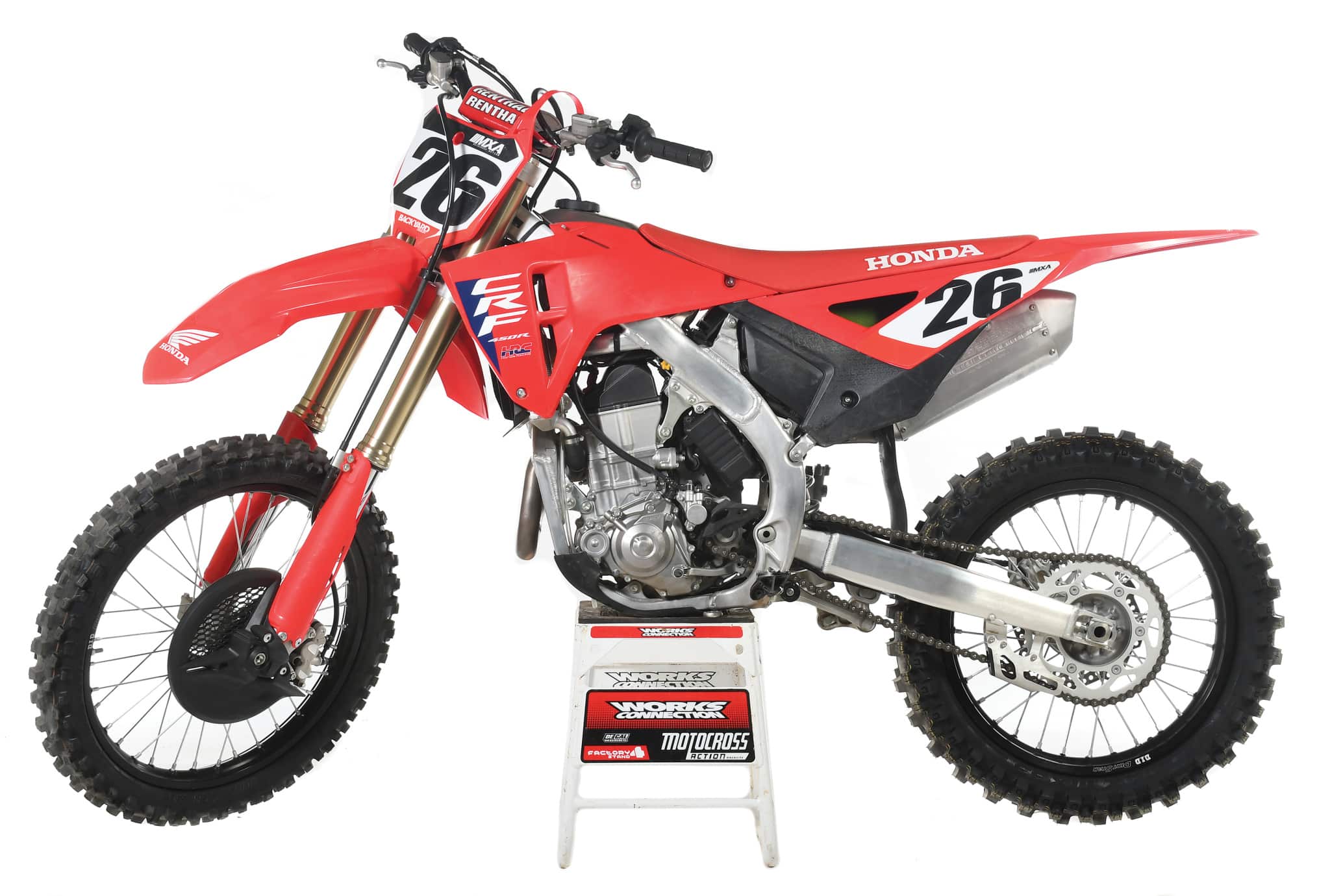 The 2025 Honda CRF450 is a clean machine. The slab-like radiator shrouds hark back to the CR500 works bikes from the 1980s.
The 2025 Honda CRF450 is a clean machine. The slab-like radiator shrouds hark back to the CR500 works bikes from the 1980s.
Q: WHERE DID HONDA SKID OFF THE TRACKS WITH THE CRF450?
A: From a historical perspective, Honda has struggled with getting the CRF450 back to the glory that it attained with the brilliant 2008 CRF450. Here is MXA’s timeline of the CRF450 missteps leading up to the all-new 2025 model.
2009 CRF450. In 2009, Honda experimented with geometry that was different from any other motocross bike ever made. It was best known as the “cab-forward design.” It was not popular and handled like a wet noddle. Unfortunately, it continued to draw criticism for the complete four-year production cycle (2009–2012).
2013 CRF450. Honda got rid of the ill-conceived cab-forward geometry in 2013, but instituted its infamous “slower is better” philosophy, which gave up as much as 5 horsepower to the competition. Additionally, Honda jumped on the ill-fated air-fork bandwagon with the consumer-mystifying Kayaba PSF air forks and kept them on the CRF450 for four distressing model years (2013–2016).
2017 CRF450. Honda tried to retreat from eight years of miscalculations by dropping the “slower is better” philosophy and the PSF air forks in 2017. Most significantly, Honda came to the realization that it could no longer ignore first-year mistakes for four years. Honda tried to fix the flaws of the 2017 CRF450 immediately and spent three years adding electric starting, better mapping, revised shock linkages, stronger brakes and, most obviously, more horsepower (culminating in the brutal 60-horsepower 2019 version). All in all, this four-year cycle (2017–2020) ended up producing incredibly powerful Hondas that overpowered their rigid frames.
2021 CRF450. Right off of the showroom floor, there were mapping and suspension issues on the 2021–2022 models. Additionally, MXA said the 2021 CRF450 was “a pure-bred motocross bike with play-bike suspension.” However, these were just blips on Honda’s radar screen caused by the limited testing done during the pandemic years. In Honda’s defense, during this four-year cycle, the CRF450 dropped 5 pounds (to get down to 233 pounds); got rid of the ridiculously stupid twin-exhaust pipes; narrowed the bodywork by 70mm; enlarged the airbox; broadened the powerband (by reducing horsepower, but not to their previous “slower is better” levels); and installed a six-spring, eight-plate, no-judder-spring, hydraulically activated clutch. These were giant leaps for Honda-kind after 12 years of miscalculations.
2024 CRF450: Although technically part of the 2021–2024 R&D cycle, there were some noticeable improvements to the 2023–2024 CRF450s. First, Honda’s 2023 engine modifications produced a milder, broader, gentler style of power. This ultra-linear powerband was, in a word, “awesome.” You would think MXA would be disappointed in the 2024 powerband because it gave up over 3 horsepower to the competition, but we loved that the throttle was more connected to the rear wheel than on any previous CRF450. Not only was it a great engine, but it did the impossible by taming some of the CRF450 frame’s skittishness. MXA felt that the 2024 CRF450 had a great engine stuffed into a questionable chassis.
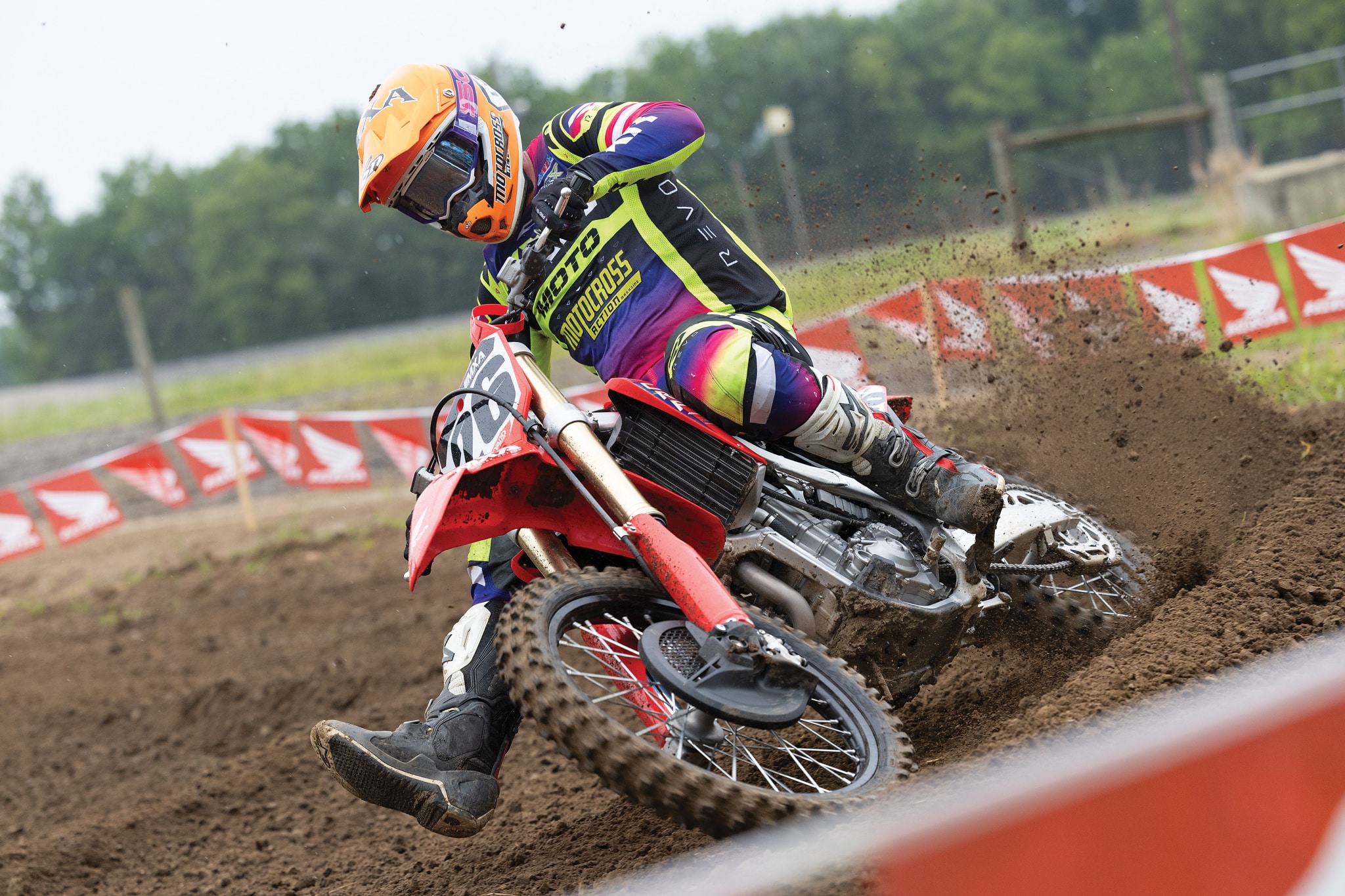 The 2025 CRF450’s “rider triangle” falls readily at hand for perfect ergos. It is sleek, slim and well proportioned.
The 2025 CRF450’s “rider triangle” falls readily at hand for perfect ergos. It is sleek, slim and well proportioned.
Q: WHAT DID HONDA CHANGE ON THE 2025 CRF450?
A: The list of 2025 changes is long but well worth the read.
(1) Frame. The 2025 frame was thoroughly tested on the Grand Prix circuit for two years. It is constructed from 70-percent new components, and the rigidity of the steering area, triple clamps, outer fork tubes, and front axle has been adjusted to optimize handling. The subframe has new mounting points to increase rigidity, and the head stays are now steel.
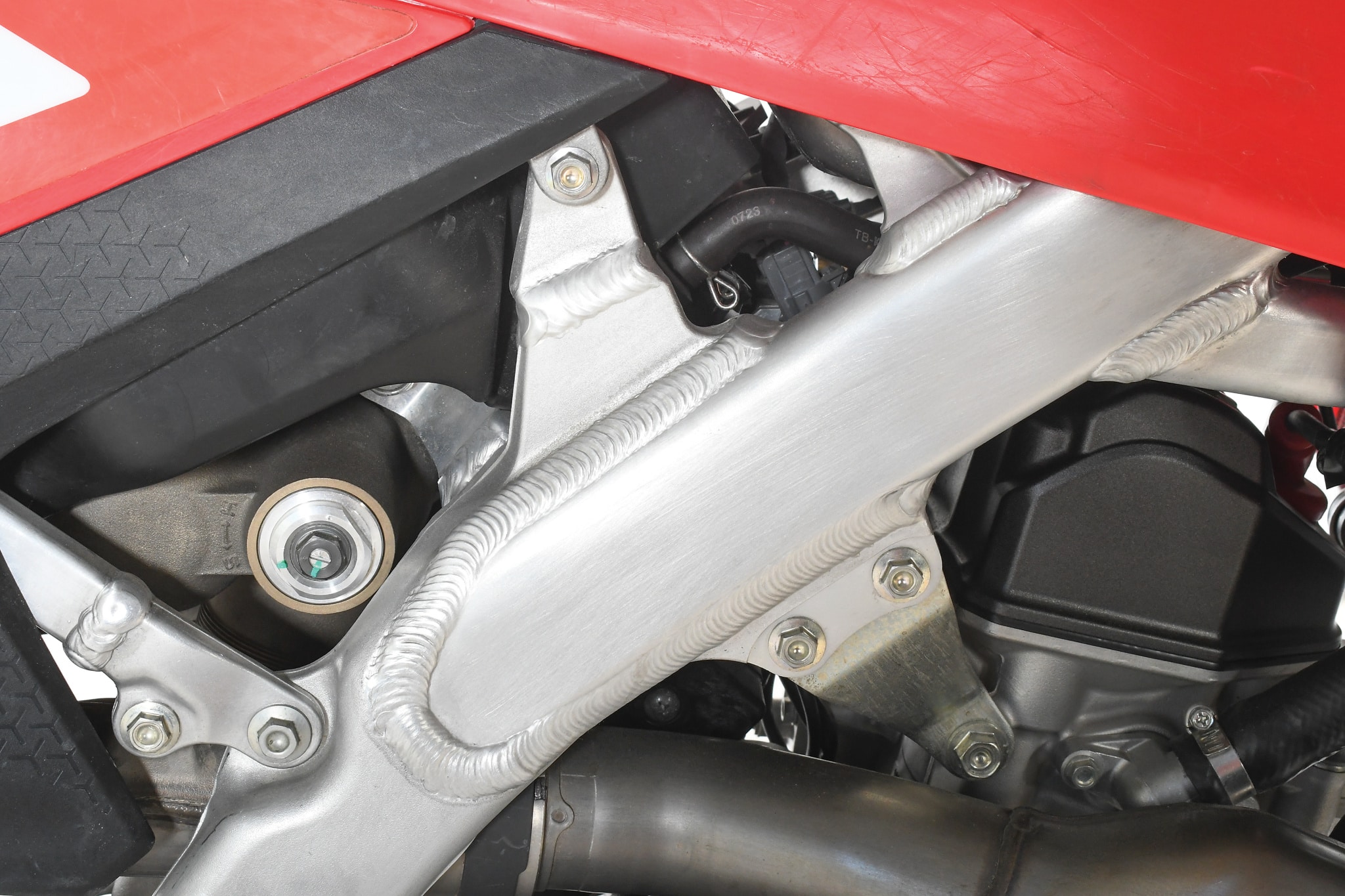 We think that the welded-on extension to this frame bracket is actually a shortened modification of an earlier part.
We think that the welded-on extension to this frame bracket is actually a shortened modification of an earlier part.
(2) Suspension. The 49mm Showa coil-spring fork features new springs, shims and seals to minimize the harsh feedback of the previous Showa units. The 2025 CRF450 triple clamps have been updated. The offset remains at 22mm, but the longer steerer tube and thicker lower clamp are designed to increase front-wheel accuracy. The upper part of the stanchion tubes have thicker tubing for more stiffness (the outer diameter remains the same). The fork spring rate is still 5.0 N/m. The fork-oil capacity is now 310cc.
As for the rear shock, a new 52 N/mm shock spring replaces last year’s 56 N/mm spring. The updated 16mm shock shaft and improved oil seal deliver a more consistent stroke. The shock linkage for 2025 is now a one-piece structure with 1/2mm-longer pull rods, which drop the rear of the bike slightly to balance out the chassis. Additionally, the pull rods are 11-percent more rigid. The bell crank features a new, stiffer rising-rate curve to decrease fore and aft pitching while improving bottoming resistance.
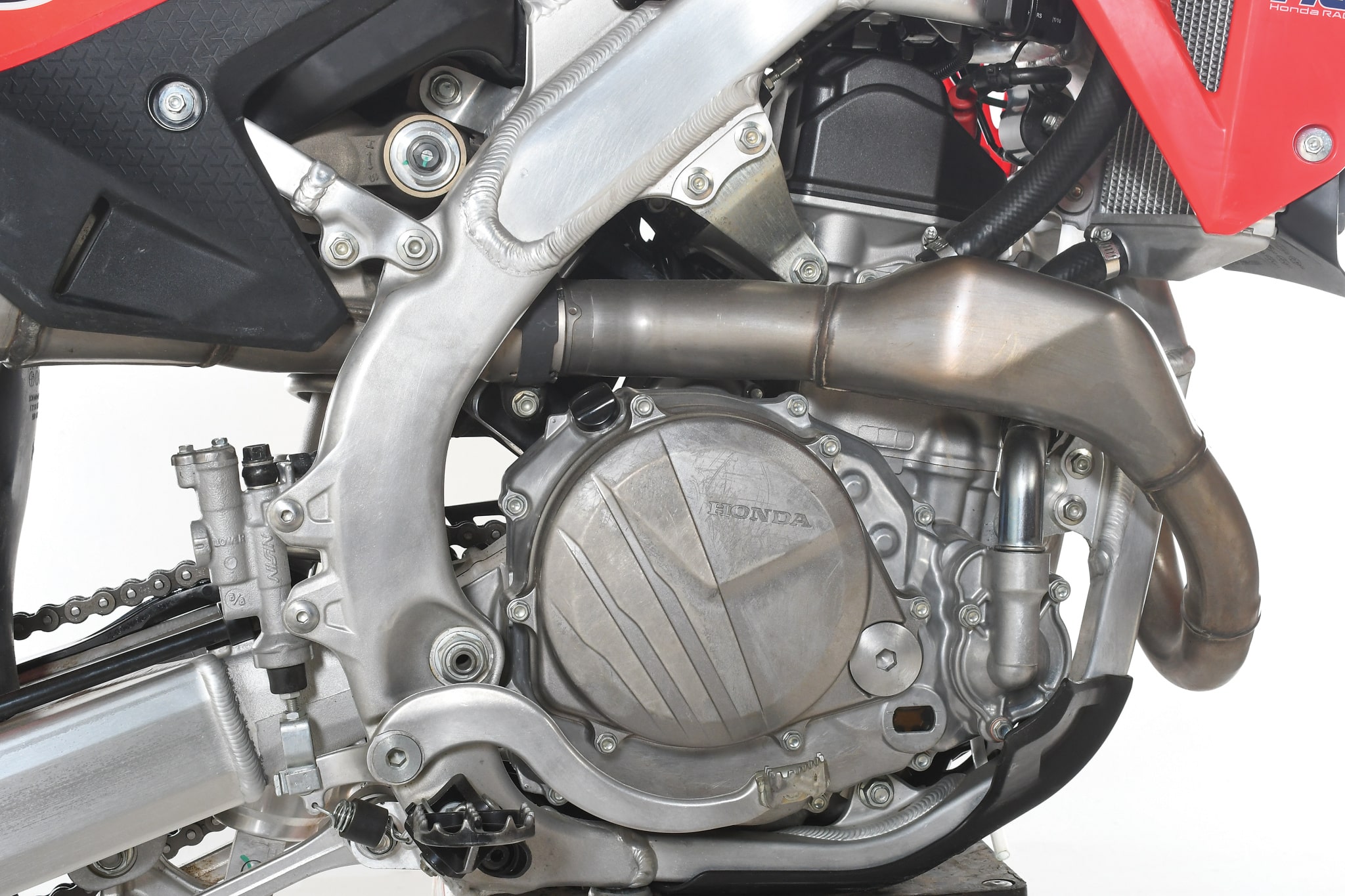 The only engine updates are the longer and straighter exhaust pipe, new airbox, and updated ECU mapping.
The only engine updates are the longer and straighter exhaust pipe, new airbox, and updated ECU mapping.
(3) Engine. The 2025 engine still owes a lot to the previous 2023–2024 powerplant—and that’s a good thing. For 2025, Honda did increase crank rigidity to enhance midrange torque. Honda straightened out and lengthened the head pipe and muffler for improved low-to-mid throttle response and updated the ECU mapping to crispier specs. The ECU’s black box, which used to be inconveniently mounted back by the rear mudflap, is now mounted behind the left-side panel for easier access. Overall, Honda kept the Unicam valvetrain and 96.0mm x 62.1mm bore and stroke that was the hallmark of this CRF450 generation. Gearing is 13/49 with a Sunstar rear sprocket.
(8) Price. In the face of rising costs, Honda somehow managed to retain its 2024 pricing; the MSRP is $9699.
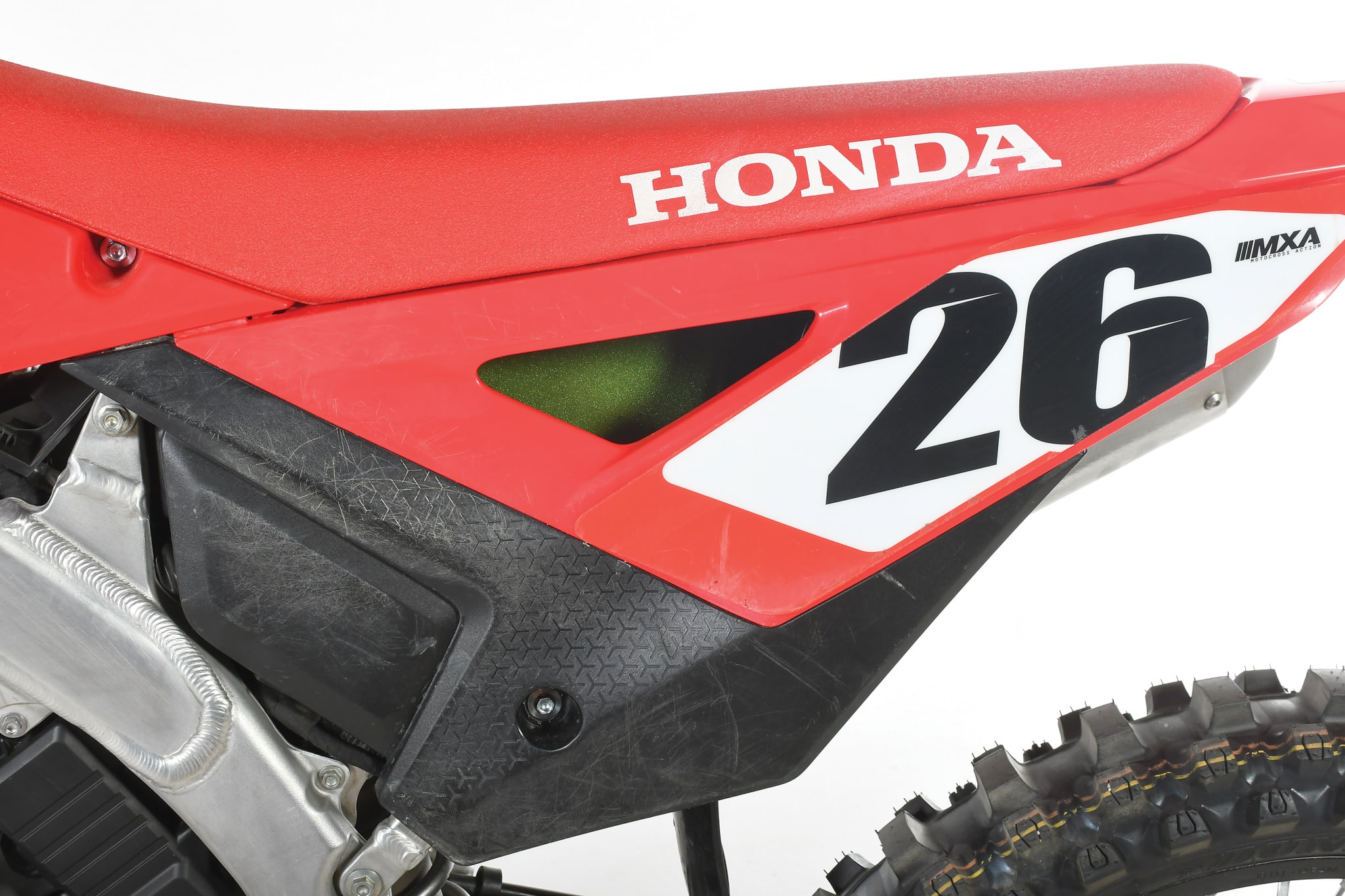 Gone is last year’s upside-down air filter. It was replaced by a copy of the HRC works airbox that Team Honda has been running on the Lawrence brothers’ CRF450s.
Gone is last year’s upside-down air filter. It was replaced by a copy of the HRC works airbox that Team Honda has been running on the Lawrence brothers’ CRF450s.
(4) Airbox. Honda drop-kicked the upside-down air filter and airbox to align the intake tract with the 44mm throttle body. The new air filter is triangular in shape and breathes through a single large vent on the left side of the bike.
(5) Brakes. To fight back against the Brembo wave, which now includes Kawasaki, the 2025 CRF450 gets a new dual-piston front brake caliper with an updated piston and seals for more consistent performance. The rear wheel comes with a single-piston Nissin caliper and a 240mm rear rotor.
(6) Bodywork. New plastics and vertical radiator shroud graphics are the most obvious updates, but there’s much more than meets the eye. Honda actually made the left-side panel and airbox cover wider for better leg grip (the right side panel was already wider to go around the muffler). The 1.7-gallon gas tank is made from titanium.
(7) Wheels. Black D.I.D DirtStar rims are found on the CRF450, combined with Dunlop Geomax MX33 tires. The front wheel features a 36-spoke, 3-cross pattern, while the rear wheel has a 32-spoke, 2-cross pattern.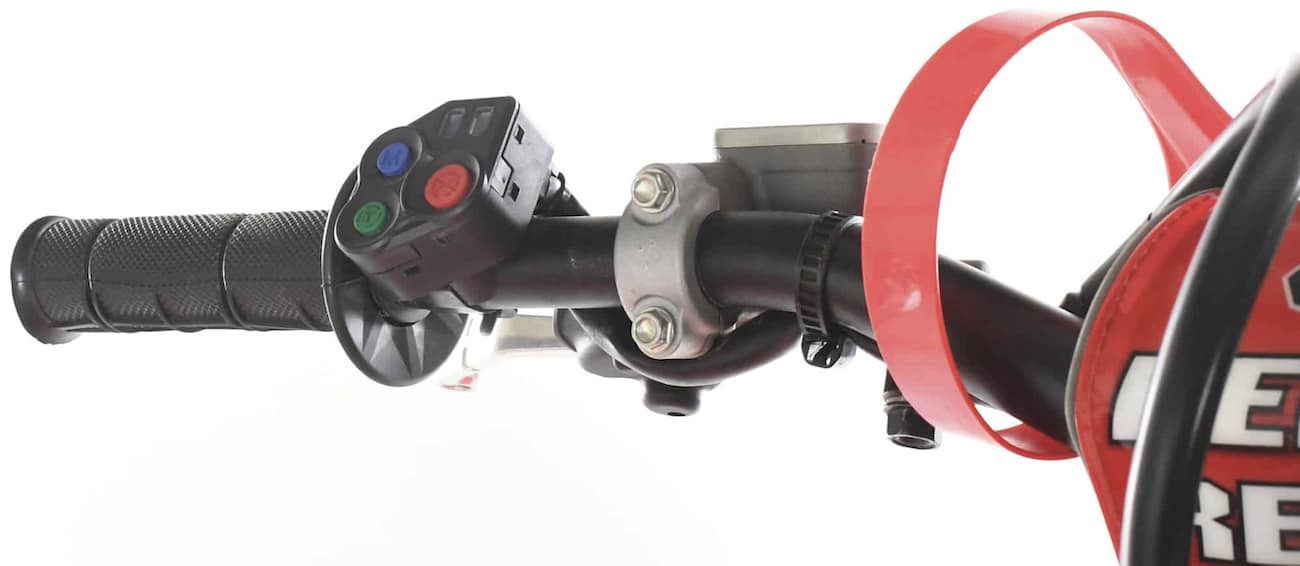 Every MXA test rider loved the 2023–2025 Honda CRF450 powerband, but the electronics are a little daunting to understand. Honda gave up peak horsepower for a more usable powerband that was rider-friendly. We preferred the stock engine settings
Every MXA test rider loved the 2023–2025 Honda CRF450 powerband, but the electronics are a little daunting to understand. Honda gave up peak horsepower for a more usable powerband that was rider-friendly. We preferred the stock engine settings
Q: WHAT ABOUT THE SUSPENSION?
A: Over the last three model years, Honda’s Showa forks have been too soft (2022), too harsh initially and too soft late in the stroke (2023), and too soft initially and too harsh in the mid-stroke (2024). Even to the trained eye, Showa just seemed to be moving the harsh spot of the damping curve around to a different place every model year. Last year we posed the question, “How long will it take before they stumble onto a singular, fluid, progressive damping curve?”
Guess what? For 2025, Showa actually designed and spec’ed fork damping to suit the average 450cc motocross rider’s needs. Yes, it did take them 16 years to realize what Kayaba learned 18 years ago when they stumbled onto the plushness of Kayaba SSS suspension, thanks to their in-house test riders.
In one of the mysteries of life, it took Showa 16 years to finally build a fork that feels plush and lacks their signature harsh spot. It is true that this fork is aimed primarily at Vet and Novice riders. Fast intermediates and pros will find it too soft. But now that Showa has found its way, it will be much easier for suspension gurus to make the forks stiffer instead of just harsher. Common sense dictates that it is easier to make a soft fork stiffer than it is to make a stiff fork softer.
Honda says that the new frame deserves a lot of credit for the improved suspension feel, not because it is softer and less rigid, but because it is stiffer and more rigid. Okay, that does sound like convoluted logic, but since very few racers own a strain gauge or access to a test lab, stiffness and harshness are universally measured by the human body, through the hands, into the shoulders, down the spine and into the feet. Racers have always relied on the human strain gauge to confirms whether the forks and shock work better—not a computer on a desk back at Honda headquarters.
As for the Showa shock, Honda has played shock-spring roulette with the spring rates for many years. This year, they spec’ed a 52 N/mm. Last year, it was a 56 N/mm, and the year before that it was 54 N/mm. Basically, Showa is making everyone happy but has taken three model years to do it. Not everyone was happy when Honda dropped the 54 N/mm shock spring for the stiffer 56 N/mm. Lighter riders might find happiness with the 52 N/mm, but it goes without saying that the big boys (over 220 pounds) will need to go back up. Showa is relying on the stiffer rising-rate curve and internal valving changes to make the 5.2 spring work. And for the majority of MXA’s test riders, it worked pretty well, most notably it was less pitchy (where the rear wheel kicks up and drives the forks down).
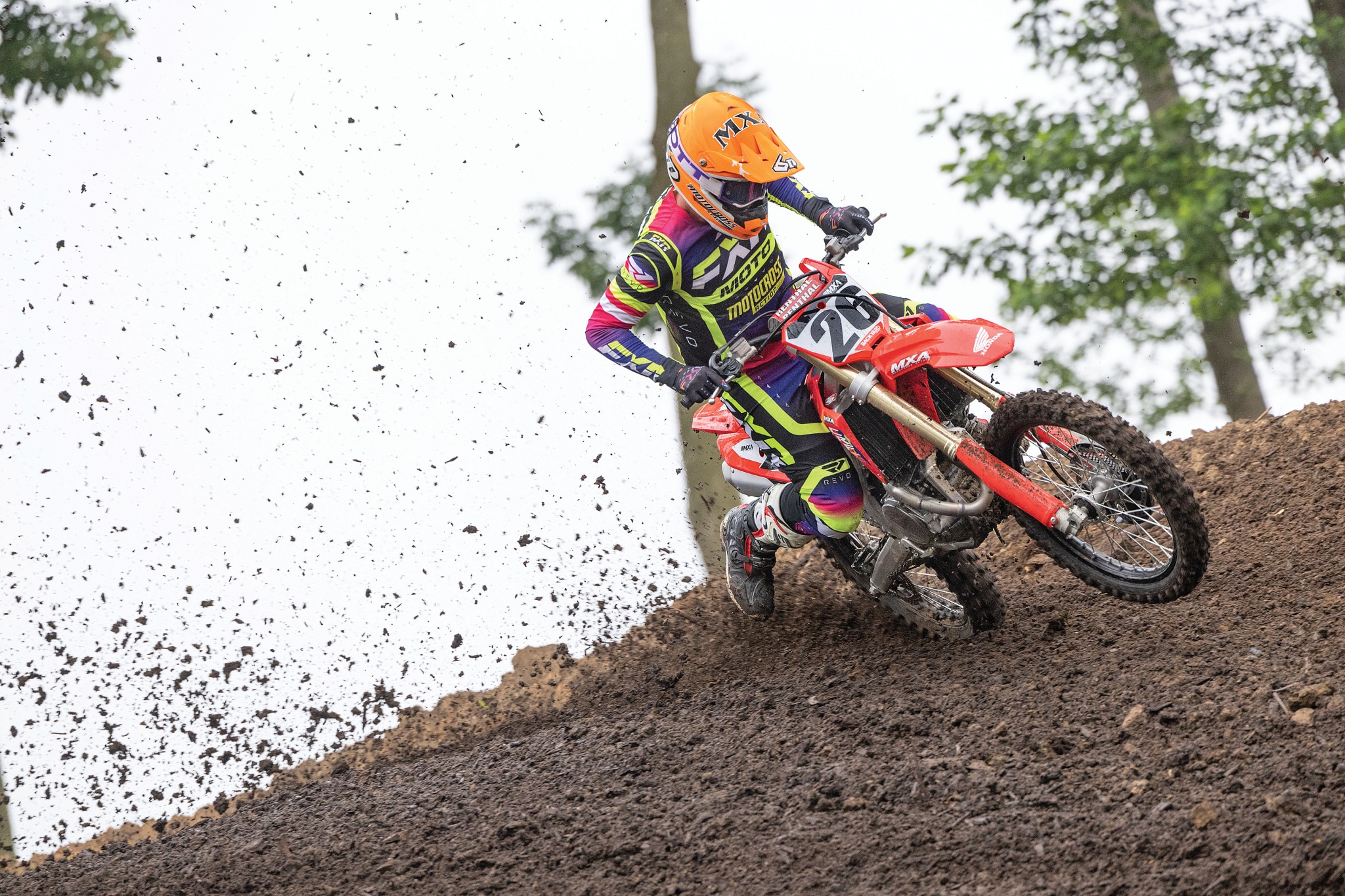 Showa’s 49mm coil-spring forks have better valving than in past years. They are on the soft side for fast or heavy riders, but perfect for Vets and Novices, which is the audience Honda wisely spec’ed the suspension for.
Showa’s 49mm coil-spring forks have better valving than in past years. They are on the soft side for fast or heavy riders, but perfect for Vets and Novices, which is the audience Honda wisely spec’ed the suspension for.
Q: HOW DOES THE 2025 HONDA CRF450 HANDLE?
A: One good trait for 2025 is the Honda CRF450’s incredible accuracy at turn-in. The 2025 CRF450 is in its happy place when tucking into the tightest corners and attacking inside lines like a champ; however, one of the Honda’s worst traits over the preceding 16 years was its instability at high speed. Every Honda CRF450 racer has a story to tell about how scary loose the CRF450 can be at speed over rough ground. It acted like it had a mind of its own about which way to go, and it wass always the polar opposite of where the rider is aiming.
Good news! The 2025 Honda CRF450 handles like a dream. It can turn tight, slide around sweepers and carve through ruts with ease. It is the best-handling Honda since the 2008 CRF450. “Light, agile and adaptive” describe how the 2025 Honda feels on the track. The awesome engine contributes a lot to this, but the chassis is finally bug-free.
Q: WHAT DID WE HATE?
A: The hate list:
(1) Shift lever. The CRF450 shift lever is 17mm shorter than a KTM shift lever. It is a struggle to get your boot under it in high-stress situations.
(2) Electronics. There are three settings available for every function. It results in information overload, and lots of riders just ignore the flashing lights.
(3) Radiators. We boiled water in the radiator until we installed a Twin Air 1.8 radiator cap instead of the stock 1.1.
(4) Air filter. The new triangular air filter isn’t very big, and it comes with a triangular wire screen. We ran it with and without the backfire screen, and it performed almost identically either way.
(5) Grips. If you like hard grips, you will love the old-school Honda grips.
(6) Brakes. Even though Honda’s engineers worked on the calipers and seals, the CRF450 brakes are not up to Brembo standards.
(7) Power. The 2025 Honda is snappy, responsive and at the ready at all times, but it isn’t the winner of the horsepower wars. It fact, it makes the least horsepower of all the 2025 450s at 55.34 horsepower.
Q: WHAT DID WE LIKE?
A: The like list:
(1) Engine. We loved it! We hated the violent, uncontrollable, 60-horsepower beasts of 2017-2019 that wreaked havoc on the previous Honda generation. The new powerband is ultra-usable, doesn’t overpower the chassis and allows the rider to choose the speed he wants. Yes, it does give-up peak power to every other 450,especially the the Husqvarna FC450 (61.1 horsepower) and Yamaha YZ450F (59.22 horsepower), but it is the strongest engine from low-to-mid. It is fun, perky and agile.
(2) Ergonomics. The rider triangle, bodywork and saddle are perfect for every body type, from endomorphs to ectomorphs. Only the short-shift lever is a faux pas.
(3) Maps. The multiple maps, launch control settings and traction-control limits verge on overkill, especially because we prefer the standard map for most situations. But, it is nice to have options—to ignore if nothing else.
(4) Gearing. The stock 13/49 gearing is in the ballpark, but some test riders preferred 13/50.
(5) Launch control. Unlike most launch control systems that retard the ignition to keep the engine from making max power when launch control is engaged, Honda offers four different rev limits for rpm at 8250 rpm, 9500 rpm, 9800 rpm and 10,700 rpm.
(6) Traction control. Honda’s ECU monitors runaway revs and responds to them by retarding the ignition to stop wheelspin. Mode 1 interacts later and lighter. Mode 2 responds quicker with more intervention. Mode 3 cuts power instantly for slippery or muddy terrain.
Q: WHAT DO WE REALLY THINK?
A: It’s been 17 years since MXA has raved about a Honda CRF450, but this one is rave-worthy. Honda addressed most of the nagging complaints we had—except for their dinky little shift lever. This is the best Honda CRF450 to come down the pike in years. It is playful, fun and agile. Giant kudos to Honda for the powerband, perfect ergos, sweet looks, new frame and flawless ergonomics. We’d rate this as the second best 450 of 2025, hampered only by is almost five horsepower deficit at peak power—which means it is bets suited to Vet and Novices..



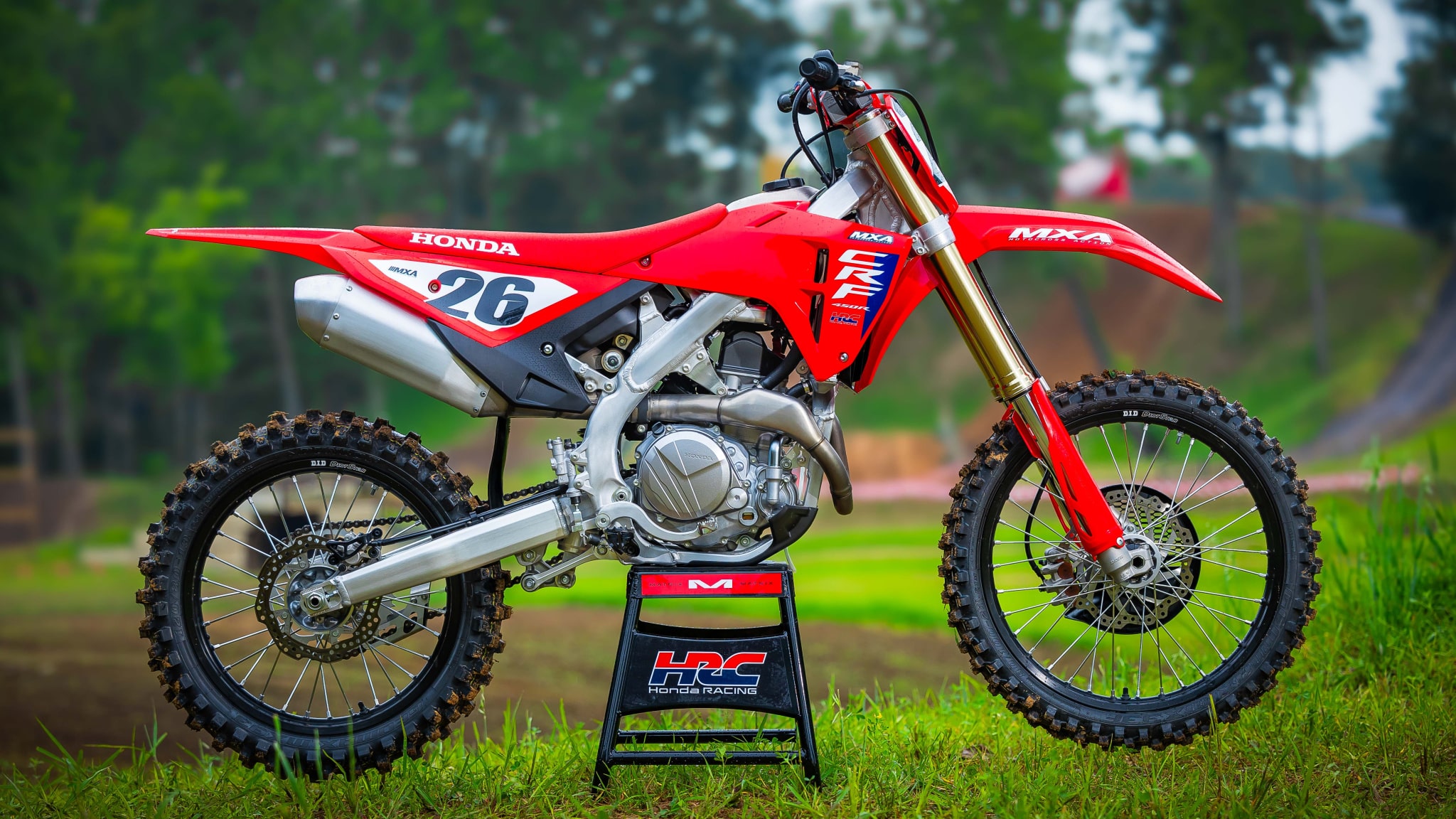
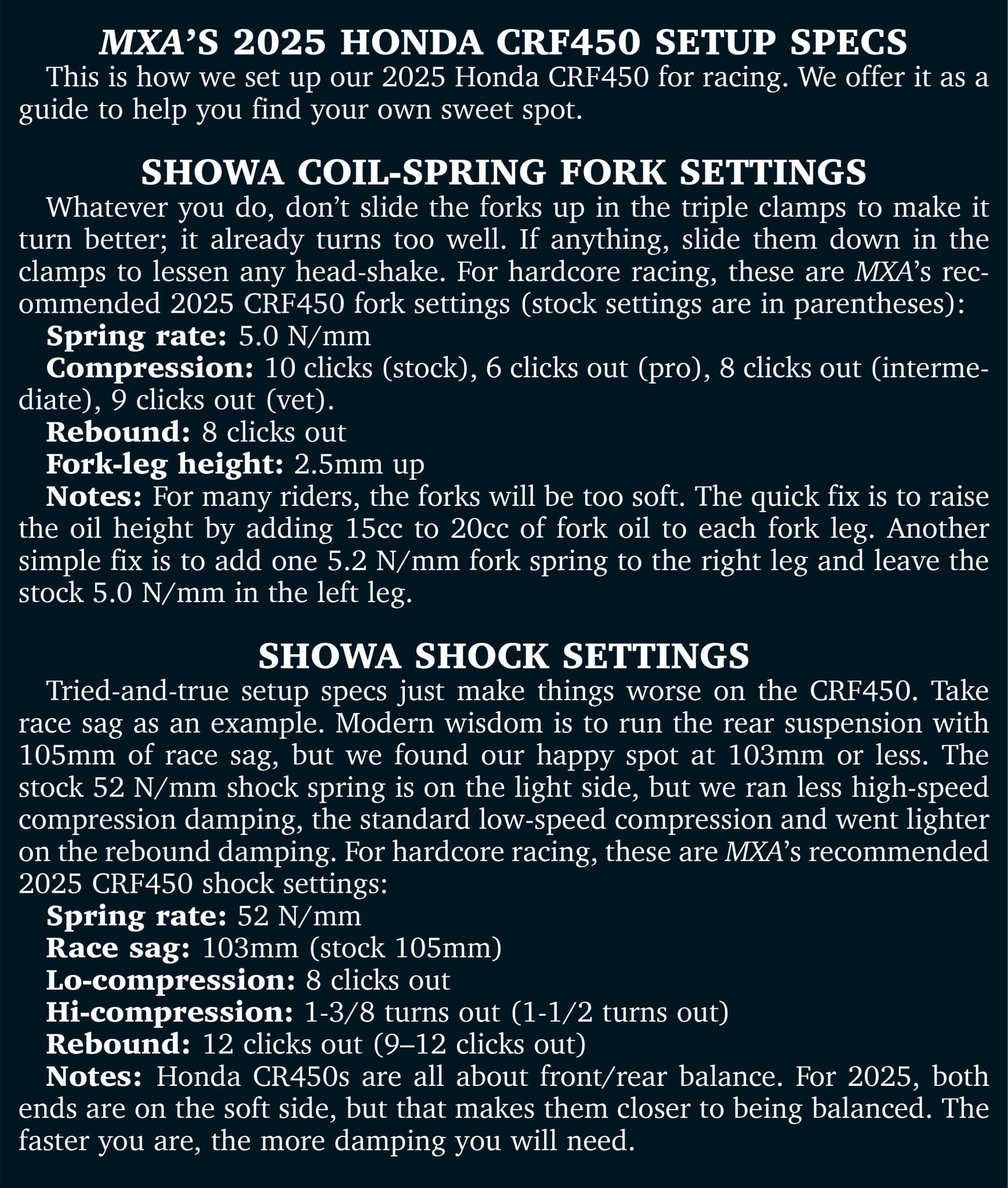



Comments are closed.